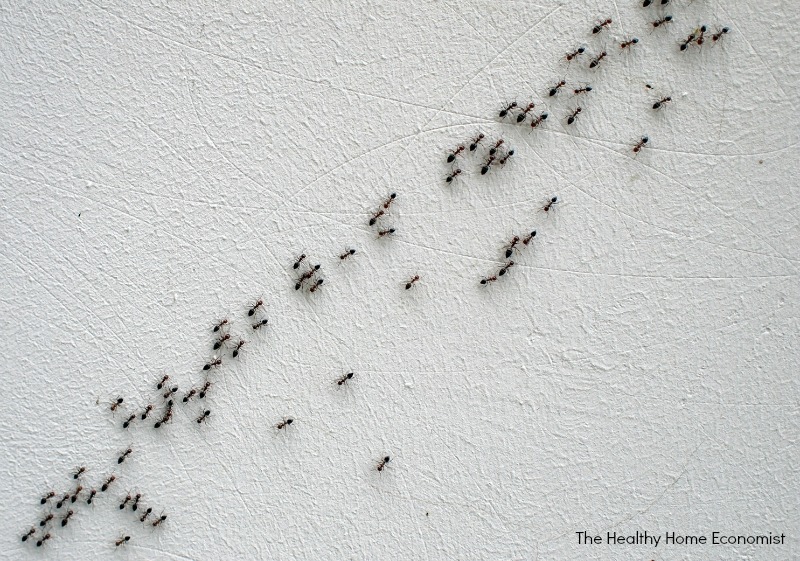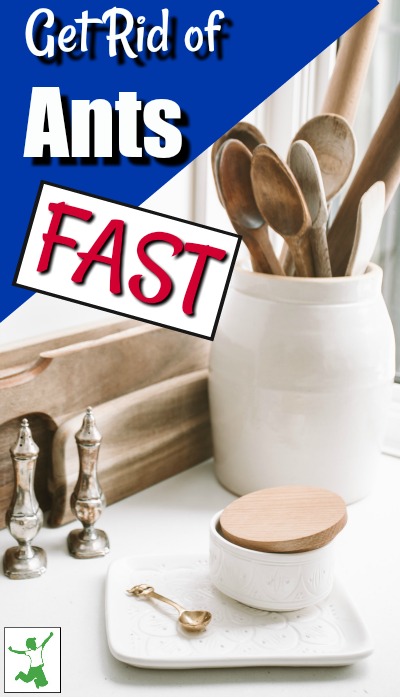Table of Contents[Hide][Show]

Every Spring they return. Tiny single file armies invading kitchens, bathrooms, and other domestic locations. Or, silently circling your picnic, waiting for the tiniest of forgotten morsels and crumbs (and sometimes not waiting!). Sadly, the ant bait available at home improvement stores or the supermarket is toxic to your home environment. How to eliminate an invasion safely without harming your family’s or pet’s health in the process?
Before we discuss how to get rid of ants in the house, let’s cover the positives of these tiny critters.
Benefits of Ants to the Environment
Ants are one of nature’s most ubiquitous and important creatures. They are found on all the continents save Antarctica. Go figure – it’s the only one named after them!
Ant colonies play a crucial role in the health of the environment, as varied as helping break down and dispose of various organic waste streams (from your picnic to an old rotten poplar tree!), or helping keep certain, even large-sized pest populations in check.
Even in endless concrete and steel cities like New York, ants remove tons of discarded food debris each year! (1)
While small in size, ants generally comprise about 15-25% of the terrestrial biomass wherever they are found. Their value goes beyond just environmental. Some species even have medical value. Certain people groups use ants as emergency stitches/staples for injuries and wounds (2). Talk about on the go medicine!
Amazing and Annoying Ants
Ants are truly amazing! But at times, they can become unwanted or even invasive and dangerous. Some species of ants bite, and some have bites that can be quite painful and even poisonous/life-threatening if someone suffers too many. Fire ant bites, for example, can trigger a dangerous allergic reaction for some people.
If a natural fire ant killer is what you need to eliminate dangerous mounds around your home, the linked article contains specific instructions and how-to video for handling that issue. Additional information on making carpenter ant bait may prove helpful as well.
But if the ants are the small, typically nonbiting kind that swarm everywhere fast and furious, read on for tips to prevent an infestation and how to eliminate an existing one with natural ant bait.
 Preventing Ant Infestation
Preventing Ant Infestation
When and where are you most likely to see ants?
In our area, ants generally become problematic during heavy Spring rains and again, in the Fall as temperatures cool and the rains return. The lack of food coupled with the presence of so much water tends to make the ants search for dryer, more comfortable accommodations, and food sources. These are the times of the year when we have to be most vigilant.
Not all regions face the same types of ants, though the two most common types – odorous house ants and carpenter ants – are generally what send people searching for solutions. Below are several different ways you can deal with these common ants.
Don’t leave food (aka ant bait) lying around
A messy house is prime ant bait and an open invitation to invade. Incidentally, it is a mouse and cockroach invitation too! Ants have a keen sense of smell, especially house ants, so unsecured foodstuffs are an ant infestation waiting to happen.
Also, realize as ants march along, they drop a pheromone trail as they go. This is why just killing the ants you see rarely works to get rid of them! Once ants have found food, your only option is to kill the entire colony (more on that below). One simple way to stop the problem is by keeping your house clean and foodstuffs and scrapes properly stored.
Seal up your house
Many people don’t’ realize how easy it is for tiny friends to enter their homes. If ants are a problem in your home, try to fix the foundation or other issues that are providing them easy access. Sealants, caulks and similar steps can reduce or outright eliminate ant invasions, along with helping to protect your home from mold and other unwanted visitors as well! Look for cracks that need to be sealed, siding that needs to be caulked, window frames that need fresh paint, and the like.
Stop inviting the ants to set up shop
Certain steps you take, such as the materials the outer edges of your house are made of, your family’s habits with leftover food bits outside near the house, and the types of mulch and landscaping you put close to your house can help discourage or encourage ant invasions. Different geographical areas require different steps, and some of these will also help protect your home from other problems, like termites (3).
If Ant Defense Doesn’t Work
If tightening up your home doesn’t work, or you are dealing with ants in an indoor location or some other place, what other options do you have that isn’t dangerous to other creatures including YOU?
Essential Oils
Ants dislike a number of scents and smells, which makes essential oils one way to drive these little friends away. Peppermint and other mint oils top of the list in effectiveness for this purpose.
Also note, ants tend to dislike the plants as well. A few patches of mint can be a simple and effective way to keep the ants at bay near doors and windows.
Mint is best planted in the ground, but pots, window, or planter boxes may also help.
Diatomaceous Earth (DE)
Diatomaceous earth is made from the ground up fossilized remains of sea phytoplankton. It works both as a weapon and deterrent for ants. It is used for a wide range of pest control issues since as long as it is handled and applied properly, it is safe for people and pets. I recommend you only get the food-grade DE since you will be handling the stuff around your family and home.
This site gives detailed instructions on using DE around your home.
If using DE outdoors, it works great in the cracks between concrete or similar little edges and gullies. Note, every time it rains, the DE will be washed away and require replacement and reapplication.
With DE, be very careful handling this product. Inhalation is contraindicated, so handle it carefully, apply only on low wind days, and wear a respirator mask (this mask is recommended). Note that DE is also excellent pest control for certain prone garden plants.
Borax Ant Bait Trap
If you have a colony of ants that just has to go, your final option is to go Ender’s Game on the little formic bugs and eliminate them. While there are many commercial products on the market that can accomplish this goal, you can also make a safe, natural, non-persistent ant buster right in your kitchen.
Supplies to Make Homemade Ant Bait
- Paper towels or cotton balls
- Sugar
- Borax
- Water
- Saucepan
DIY Ant Trap Instructions
The sugar serves as the ant attractant. The borax is the ant killer. The cotton balls or paper towels bind it all together and create a convenient, easy medium that the little creatures can grab and go with.
- Place one cup of water in saucepan and warm to slightly.
- Mix in ½ cup sugar and 3 tablespoons borax.
- Soak up the mixture with cotton balls or paper towels.
- Place the towels or cotton balls in shallow dishes near where you see ants. We will often place them in nut butter or similar shallow jar lids.
- Whatever you do, don’t kill the ants you see! You want them to eat the cotton balls or paper towels and take it back to the nest, where the borax will disrupt the entire colony.
The above method takes about two to five days to be fully effective. Unlike DE or essential oils, generally, it is a more long term permanent solution. Once a colony is wiped out, it is gone for good.
We have successfully used borax traps for colonies infesting certain spots in our garden and growing beds, firewood piles, and other locations too. The key is to ensure the trap doesn’t get rained on or wet in any way. This gives the ants ample opportunity to eat as much of the bait as possible.
Ants Away
If you have to get rid of an ant colony or two, I wouldn’t worry too much about it. Ants have already survived a mass extinction event. In addition, researchers Bert Hölldobler and Edward O. Wilson estimate that there are upwards of 10,000,000,000,000,000 (10,000 trillion) individual ants alive on Earth at any given time (4). Clearly, taking out a colony or two to protect your home on occasion is not an issue for the survival of the species!








Thank you, I’d lost the recipe years ago and just used a peppermint spray.? It’s temporary but it smells great. And thank you for all your wonder suggestions and tips. I can only imagine the time it takes to do research and compile the pro’s and con’s.. Oh and did you know Hawaii never had ants before contact with foreigners.. We could sleep on the ground.. Haha.!! Thanks Again and Mahalo.